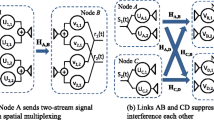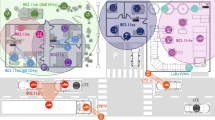Abstract
In this paper, we propose a new integrated framework for joint routing and rate adaptation in multi-rate multi-hop wireless networks. Unlike many previous efforts, our framework considers several factors that affect end-to-end performance. Among these factors, the framework takes into account the effect of the relative positions of the links on a path when choosing the rates of operation and the importance of avoiding congested areas. The key element of our framework is a new comprehensive path metric that we call ETM (for expected transmission cost in multi-rate wireless networks). We analytically derive the ETM metric. We show that the ETM metric can be used to determine the best end-to-end path with a greedy routing approach. We also show that the metric can be used to dynamically select the best transmission rate for each link on the path via a dynamic programming approach. We implement the ETM-framework on an indoor wireless mesh network and compare its performance with that of frameworks based on the popular ETT and the recently proposed ETOP metrics. Our experiments demonstrate that the ETM-framework can yield throughput improvements of up to 253 and 368 % as compared with the ETT and ETOP frameworks.







Similar content being viewed by others
Notes
We discuss how this is measured in our implementation later.
When the distribution of the data is skewed (as it is in our case), the median is more representative of the observed behaviors than the mean [34].
References
Jakllari, G., Eidenbenz, S., Hengartner, N., Krishnamurthy, S. V., & Faloutsos, M. (2008). Link positions matter: A noncommutative routing metric for wireless mesh network. In INFOCOM 2008. The 27th conference on computer communications. IEEE, pp. 744–752.
De Couto, D. S. J., Aguayo, D., Bicket, J., & Morris, R. (2005). A high-throughput path metric for multi-hop wireless routing. Wireless Networks, 11(4), 419–434.
Draves, R., Padhye, J., & Zill, B. (2004). Routing in multi-radio, multi-hop wireless mesh networks. In Proceedings of the 10th annual international conference on mobile computing and networking (MobiCom ’04) (pp. 114–128). New York, NY: ACM.
Bicket, J., Aguayo, D., Biswas, S., & Morris, R. (2005). Architecture and evaluation of an unplanned 802.11b mesh network. In Proceedings of the 11th annual international conference on mobile computing and networking (MobiCom ’05) (pp. 31–42). New York, NY: ACM.
Lacage, M., Manshaei, M. H., & Turletti, T. (2004). IEEE 802.11 rate adaptation: A practical approach. In Proceedings of the 7th ACM international symposium on modeling, analysis and simulation of wireless and mobile systems (MSWiM ’04) (pp. 126–134). New York, NY: ACM.
Choi, J., Na, J., Park, K., & Kim, C. K. (2007). Adaptive optimization of rate adaptation algorithms in multi-rate WLANS. In IEEE international conference on network protocols, 2007 (ICNP 2007)., pp. 144–153.
Qiao, D., & Choi, S. (2005). Fast-responsive link adaptation for IEEE 802.11 WLANs. In IEEE international conference on communications, 2005 (ICC 2005)., Vol. 5, pp. 3583–3588.
Holland, G., Vaidya, N. H., & Bahl, P. (2001). A rate-adaptive mac protocol for multi-hop wireless networks. In Proceedings of the 7th annual international conference on mobile computing and networking (MobiCom ’01), Rome, Italy (pp. 236–251). New York, NY: ACM.
Zhu, H., & Cao, G. (2005). rDCF: A relay-enabled medium access control protocol for wireless ad hoc networks. In INFOCOM 2005. 24th annual joint conference of the IEEE computer and communications societies, Vol. 1, pp. 12–22.
Sadeghi, B., Kanodia, V., Sabharwal, A., & Knightly, E. (2002). Opportunistic media access for multirate ad hoc networks. In Proceedings of the 8th annual international conference on mobile computing and networking (MobiCom ’02) (pp. 24–35). New York, NY: ACM.
Kamerman, A., & Monteban, L. (1997). WaveLAN II: A high-performance wireless LAN for the unlicensed band. Bell Labs Technical Journal, 118–133.
MadWifi, Multiband Atheros Driver for WiFi. http://www.madwifi.org/.
Bejerano, Y., Han, S., & Kumar, A. (2007). Efficient load-balancing routing for wireless mesh networks. Computer Networks, 51, 2450–2466.
Mhatre, V., Baccelli, F., Lundgren, H., & Diot, C. (2007). Joint MAC-aware routing and load balancing in mesh networks. In ACM CoNEXT.
Kohler, E., Morris, R., Chen, B., & Jannotti, J. (2000). The click modular router. ACM Transactions on Computer Systems (TOCS), 18(3), 263–297.
Draves, R., Padhye, J., & Zill, B. (2004). Comparison of routing metrics for static multi-hop wireless networks. In ACM Sigcomm.
Paris, S., Nita-Rotaru, C., Martignon, F., & Capone, A. (2011). EFW: A cross-layer metric for reliable routing in wireless mesh networks with selfish participants. In INFOCOM, 2011, pp. 576–580.
Qi, B., Shen, F., & Raza, S. (2012). iBATD: A new routing metric for multi-radio wireless mesh networks. In 2012 ninth international conference on information technology: New generations (ITNG), pp. 502–507.
Razak, S., Kolar, V., & Abu-Ghazaleh, N. B. (2010). A MAC interaction aware routing metric in wireless network. In Proceedings of the 13th ACM international conference on modeling, analysis, and simulation of wireless and mobile systems (MSWIM ’10), (pp. 118–121). New York, NY: ACM.
Koksal, C., & Balakrishnan, H. (2006). Quality-aware routing metrics for time-varying wireless mesh networks. IEEE Journal on Selected Areas in Communications, 24(11), 1984–1994.
Banerjee, S., & Misra, A. (2002). Minimum energy paths for reliable communication in multi-hop wireless networks. In ACM Mobihoc.
Dong, Q., Banerjee, S., Adler, M., & Misra, A. (2005). Minimum energy reliable paths using unreliable wireless links. In Proceedings of the 6th ACM international symposium on mobile ad hoc networking and computing (MobiHoc ’05) (pp. 449–459). New York, NY: ACM.
Proakis, J. (2000). Digital communications. McGrawHill
Qiao, D., & Choi, S. (2001). Goodput enhancement of ieee 802.11a wireless lan via link adaptation. In IEEE ICC.
IEEE Standard for Wireless LAN Medium Access Control (MAC) and Physical Layer (PHY) specifications. ISO/IEC 8802-11:2005/Amd.4:2006(E).
Tickoo, O., & Sikdar, B. (2004). Queuing analysis and delay mitigation in IEEE 802.11 random access MAC based wireless networks. In IEEE Infocom.
Engelstad, P., & Østerbø, N. (2006). Queuing delay analysis of IEEE 802.11e EDCA. In 3rd annual conference on wireless on-demand network systems and services.
Sobrinho, J. L. (2001). Algebra and algorithms for qos path computation and hop-by-hop routing in the internet. IEEE/ACM Transactions on Networking, 10(4), 541–550.
Yang Y., & Wang, J. (2008). Design guidelines for routing metrics in multihop wireless networks. In INFOCOM 2008. The 27th conference on computer communications. IEEE, pp. 1615–1623.
Cormen, T., Leiserson, C., & Rivest, R. (2000). Introduction to algorithms. McGrawHill.
CM9 802.11 a/b/g wireless card. http://www.wneweb.com/.
Johnson, D., Maltz, D., & Broch, J. (2001). Dsr: The dynamic source routing protocol for multi-hop wireless ad hoc networks, chapter 5. In Ad hoc networking, pp. 139–172.
Iperf-tool. http://dast.nlanr.net/projects/iperf/.
Jain, R. (1991). The art of computer systems performance analysis. John Wiley and Sons.
The Click Modular Router Project. http://www.read.cs.ucla.edu/click/.
Author information
Authors and Affiliations
Corresponding author
Additional information
A preliminary version of this paper appeared in IEEE International Conference on Mobile Ad-hoc and Sensor Systems (MASS) 2011.
Rights and permissions
About this article
Cite this article
Kim, TS., Jakllari, G., Krishnamurthy, S.V. et al. An integrated routing and rate adaptation framework for multi-rate multi-hop wireless networks. Wireless Netw 19, 985–1003 (2013). https://doi.org/10.1007/s11276-012-0513-5
Published:
Issue Date:
DOI: https://doi.org/10.1007/s11276-012-0513-5




